Application of Lewin's Change Model to ICU Staffing Issues Report
VerifiedAdded on 2022/09/30
|10
|2359
|26
Report
AI Summary
This report examines the application of Lewin's Change Model to address staffing challenges in Intensive Care Units (ICUs). It begins with an overview of the need for change, emphasizing the impact of staffing issues on patient safety and quality of care. The report details how Lewin's three-step model (unfreeze, change, refreeze) can be used to manage the introduction of retired nurses to guide newly recruited staff. It explores the influence of factors such as staff reality shock, organizational culture, employer expectations for continuous improvement, interpersonal relationships, and unhealthy work environments on the implementation of change. The paper also identifies key challenges, including financial constraints and resistance to change, and proposes strategies to overcome these obstacles. Ultimately, the report concludes that the strategic implementation of Lewin's model, coupled with addressing the identified challenges, can improve job satisfaction for new nurses, promote efficient work delivery, and enhance patient outcomes in the ICU environment.
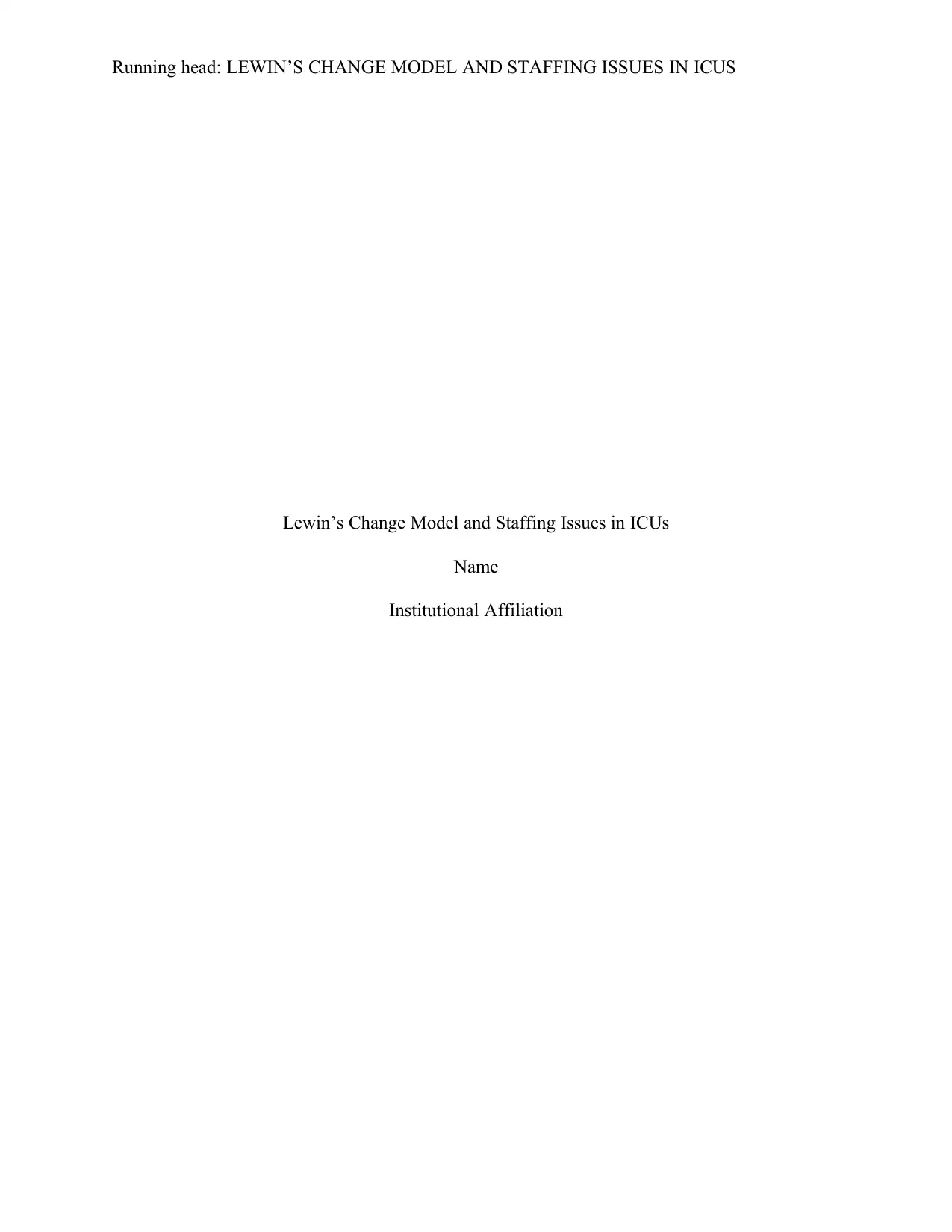
Running head: LEWIN’S CHANGE MODEL AND STAFFING ISSUES IN ICUS
Lewin’s Change Model and Staffing Issues in ICUs
Name
Institutional Affiliation
Lewin’s Change Model and Staffing Issues in ICUs
Name
Institutional Affiliation
Paraphrase This Document
Need a fresh take? Get an instant paraphrase of this document with our AI Paraphraser
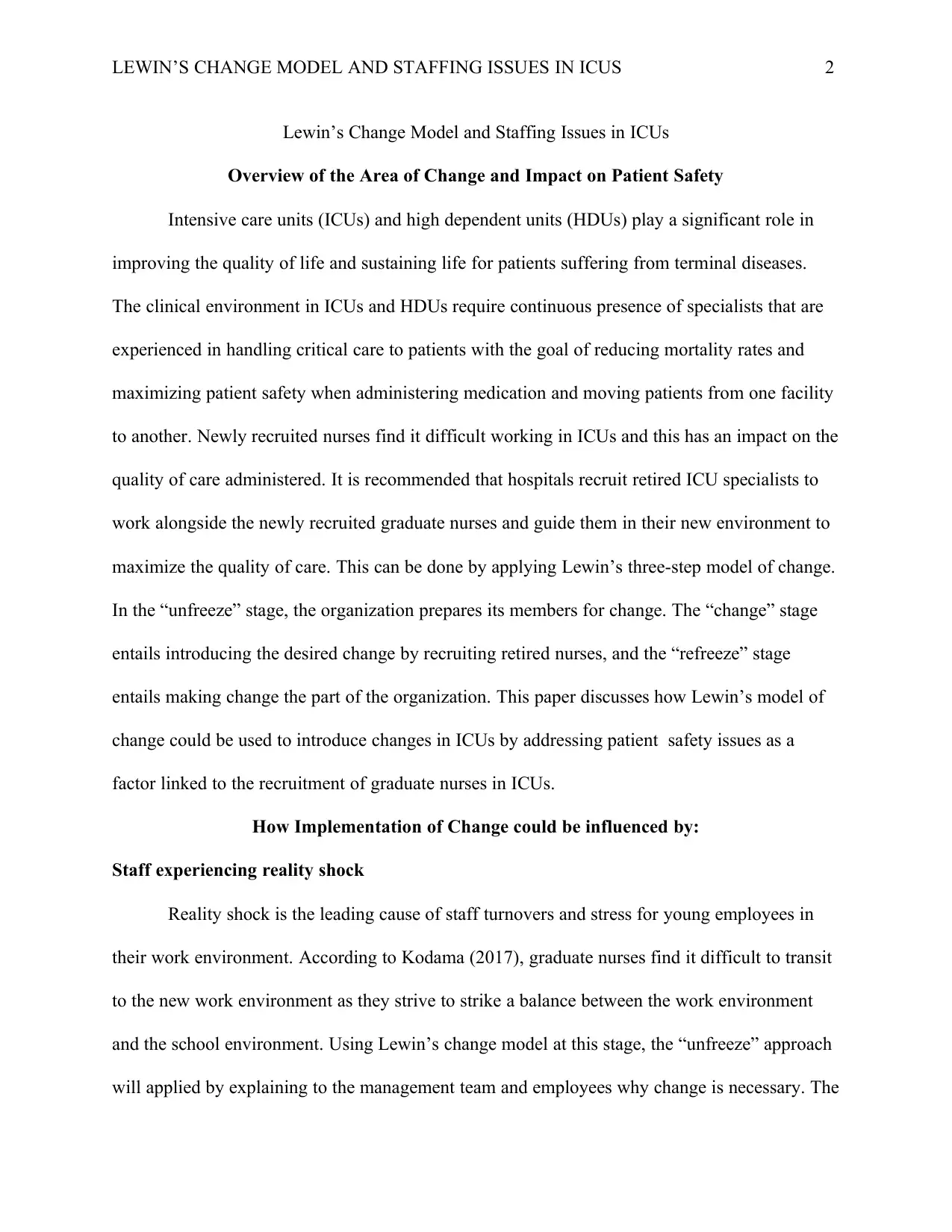
LEWIN’S CHANGE MODEL AND STAFFING ISSUES IN ICUS 2
Lewin’s Change Model and Staffing Issues in ICUs
Overview of the Area of Change and Impact on Patient Safety
Intensive care units (ICUs) and high dependent units (HDUs) play a significant role in
improving the quality of life and sustaining life for patients suffering from terminal diseases.
The clinical environment in ICUs and HDUs require continuous presence of specialists that are
experienced in handling critical care to patients with the goal of reducing mortality rates and
maximizing patient safety when administering medication and moving patients from one facility
to another. Newly recruited nurses find it difficult working in ICUs and this has an impact on the
quality of care administered. It is recommended that hospitals recruit retired ICU specialists to
work alongside the newly recruited graduate nurses and guide them in their new environment to
maximize the quality of care. This can be done by applying Lewin’s three-step model of change.
In the “unfreeze” stage, the organization prepares its members for change. The “change” stage
entails introducing the desired change by recruiting retired nurses, and the “refreeze” stage
entails making change the part of the organization. This paper discusses how Lewin’s model of
change could be used to introduce changes in ICUs by addressing patient safety issues as a
factor linked to the recruitment of graduate nurses in ICUs.
How Implementation of Change could be influenced by:
Staff experiencing reality shock
Reality shock is the leading cause of staff turnovers and stress for young employees in
their work environment. According to Kodama (2017), graduate nurses find it difficult to transit
to the new work environment as they strive to strike a balance between the work environment
and the school environment. Using Lewin’s change model at this stage, the “unfreeze” approach
will applied by explaining to the management team and employees why change is necessary. The
Lewin’s Change Model and Staffing Issues in ICUs
Overview of the Area of Change and Impact on Patient Safety
Intensive care units (ICUs) and high dependent units (HDUs) play a significant role in
improving the quality of life and sustaining life for patients suffering from terminal diseases.
The clinical environment in ICUs and HDUs require continuous presence of specialists that are
experienced in handling critical care to patients with the goal of reducing mortality rates and
maximizing patient safety when administering medication and moving patients from one facility
to another. Newly recruited nurses find it difficult working in ICUs and this has an impact on the
quality of care administered. It is recommended that hospitals recruit retired ICU specialists to
work alongside the newly recruited graduate nurses and guide them in their new environment to
maximize the quality of care. This can be done by applying Lewin’s three-step model of change.
In the “unfreeze” stage, the organization prepares its members for change. The “change” stage
entails introducing the desired change by recruiting retired nurses, and the “refreeze” stage
entails making change the part of the organization. This paper discusses how Lewin’s model of
change could be used to introduce changes in ICUs by addressing patient safety issues as a
factor linked to the recruitment of graduate nurses in ICUs.
How Implementation of Change could be influenced by:
Staff experiencing reality shock
Reality shock is the leading cause of staff turnovers and stress for young employees in
their work environment. According to Kodama (2017), graduate nurses find it difficult to transit
to the new work environment as they strive to strike a balance between the work environment
and the school environment. Using Lewin’s change model at this stage, the “unfreeze” approach
will applied by explaining to the management team and employees why change is necessary. The
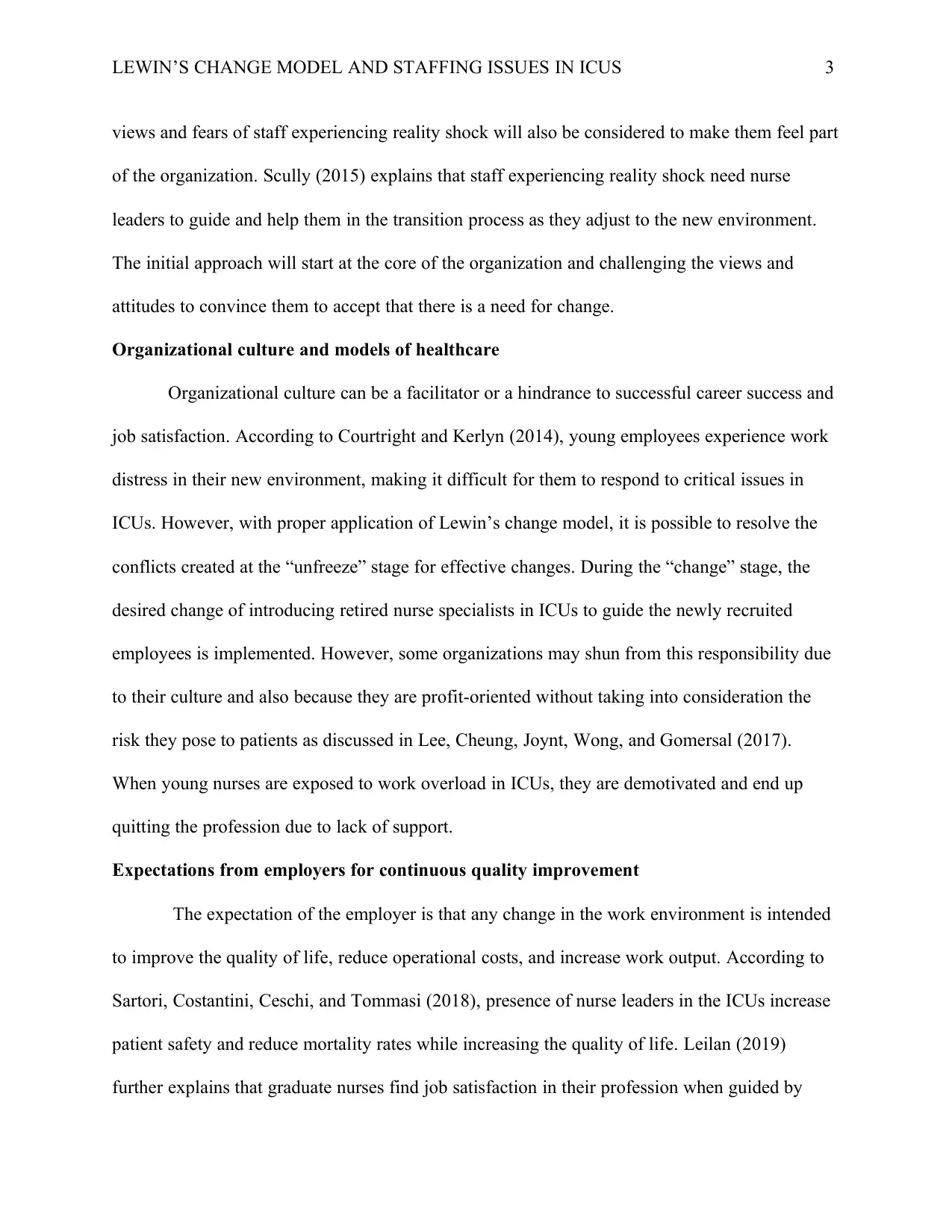
LEWIN’S CHANGE MODEL AND STAFFING ISSUES IN ICUS 3
views and fears of staff experiencing reality shock will also be considered to make them feel part
of the organization. Scully (2015) explains that staff experiencing reality shock need nurse
leaders to guide and help them in the transition process as they adjust to the new environment.
The initial approach will start at the core of the organization and challenging the views and
attitudes to convince them to accept that there is a need for change.
Organizational culture and models of healthcare
Organizational culture can be a facilitator or a hindrance to successful career success and
job satisfaction. According to Courtright and Kerlyn (2014), young employees experience work
distress in their new environment, making it difficult for them to respond to critical issues in
ICUs. However, with proper application of Lewin’s change model, it is possible to resolve the
conflicts created at the “unfreeze” stage for effective changes. During the “change” stage, the
desired change of introducing retired nurse specialists in ICUs to guide the newly recruited
employees is implemented. However, some organizations may shun from this responsibility due
to their culture and also because they are profit-oriented without taking into consideration the
risk they pose to patients as discussed in Lee, Cheung, Joynt, Wong, and Gomersal (2017).
When young nurses are exposed to work overload in ICUs, they are demotivated and end up
quitting the profession due to lack of support.
Expectations from employers for continuous quality improvement
The expectation of the employer is that any change in the work environment is intended
to improve the quality of life, reduce operational costs, and increase work output. According to
Sartori, Costantini, Ceschi, and Tommasi (2018), presence of nurse leaders in the ICUs increase
patient safety and reduce mortality rates while increasing the quality of life. Leilan (2019)
further explains that graduate nurses find job satisfaction in their profession when guided by
views and fears of staff experiencing reality shock will also be considered to make them feel part
of the organization. Scully (2015) explains that staff experiencing reality shock need nurse
leaders to guide and help them in the transition process as they adjust to the new environment.
The initial approach will start at the core of the organization and challenging the views and
attitudes to convince them to accept that there is a need for change.
Organizational culture and models of healthcare
Organizational culture can be a facilitator or a hindrance to successful career success and
job satisfaction. According to Courtright and Kerlyn (2014), young employees experience work
distress in their new environment, making it difficult for them to respond to critical issues in
ICUs. However, with proper application of Lewin’s change model, it is possible to resolve the
conflicts created at the “unfreeze” stage for effective changes. During the “change” stage, the
desired change of introducing retired nurse specialists in ICUs to guide the newly recruited
employees is implemented. However, some organizations may shun from this responsibility due
to their culture and also because they are profit-oriented without taking into consideration the
risk they pose to patients as discussed in Lee, Cheung, Joynt, Wong, and Gomersal (2017).
When young nurses are exposed to work overload in ICUs, they are demotivated and end up
quitting the profession due to lack of support.
Expectations from employers for continuous quality improvement
The expectation of the employer is that any change in the work environment is intended
to improve the quality of life, reduce operational costs, and increase work output. According to
Sartori, Costantini, Ceschi, and Tommasi (2018), presence of nurse leaders in the ICUs increase
patient safety and reduce mortality rates while increasing the quality of life. Leilan (2019)
further explains that graduate nurses find job satisfaction in their profession when guided by
⊘ This is a preview!⊘
Do you want full access?
Subscribe today to unlock all pages.

Trusted by 1+ million students worldwide
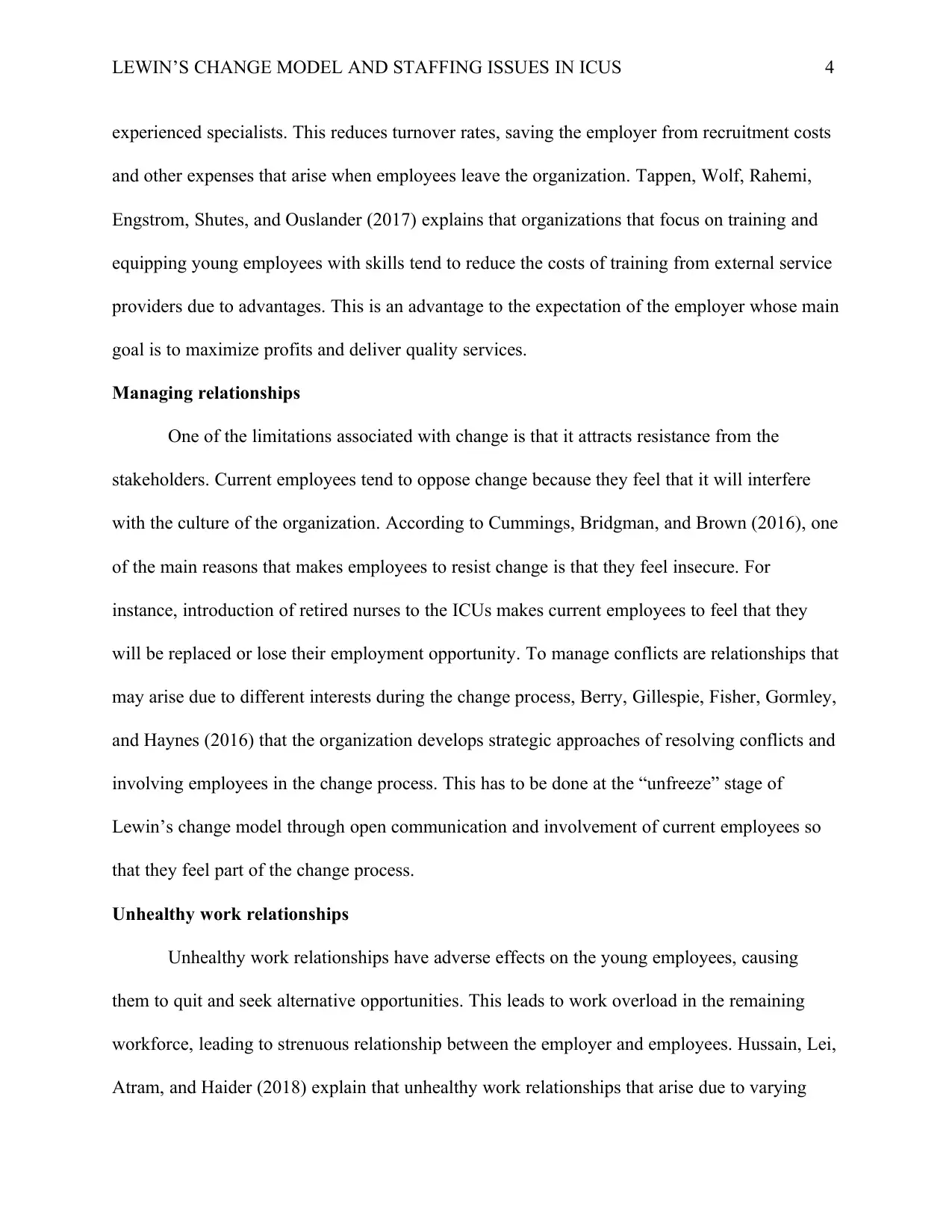
LEWIN’S CHANGE MODEL AND STAFFING ISSUES IN ICUS 4
experienced specialists. This reduces turnover rates, saving the employer from recruitment costs
and other expenses that arise when employees leave the organization. Tappen, Wolf, Rahemi,
Engstrom, Shutes, and Ouslander (2017) explains that organizations that focus on training and
equipping young employees with skills tend to reduce the costs of training from external service
providers due to advantages. This is an advantage to the expectation of the employer whose main
goal is to maximize profits and deliver quality services.
Managing relationships
One of the limitations associated with change is that it attracts resistance from the
stakeholders. Current employees tend to oppose change because they feel that it will interfere
with the culture of the organization. According to Cummings, Bridgman, and Brown (2016), one
of the main reasons that makes employees to resist change is that they feel insecure. For
instance, introduction of retired nurses to the ICUs makes current employees to feel that they
will be replaced or lose their employment opportunity. To manage conflicts are relationships that
may arise due to different interests during the change process, Berry, Gillespie, Fisher, Gormley,
and Haynes (2016) that the organization develops strategic approaches of resolving conflicts and
involving employees in the change process. This has to be done at the “unfreeze” stage of
Lewin’s change model through open communication and involvement of current employees so
that they feel part of the change process.
Unhealthy work relationships
Unhealthy work relationships have adverse effects on the young employees, causing
them to quit and seek alternative opportunities. This leads to work overload in the remaining
workforce, leading to strenuous relationship between the employer and employees. Hussain, Lei,
Atram, and Haider (2018) explain that unhealthy work relationships that arise due to varying
experienced specialists. This reduces turnover rates, saving the employer from recruitment costs
and other expenses that arise when employees leave the organization. Tappen, Wolf, Rahemi,
Engstrom, Shutes, and Ouslander (2017) explains that organizations that focus on training and
equipping young employees with skills tend to reduce the costs of training from external service
providers due to advantages. This is an advantage to the expectation of the employer whose main
goal is to maximize profits and deliver quality services.
Managing relationships
One of the limitations associated with change is that it attracts resistance from the
stakeholders. Current employees tend to oppose change because they feel that it will interfere
with the culture of the organization. According to Cummings, Bridgman, and Brown (2016), one
of the main reasons that makes employees to resist change is that they feel insecure. For
instance, introduction of retired nurses to the ICUs makes current employees to feel that they
will be replaced or lose their employment opportunity. To manage conflicts are relationships that
may arise due to different interests during the change process, Berry, Gillespie, Fisher, Gormley,
and Haynes (2016) that the organization develops strategic approaches of resolving conflicts and
involving employees in the change process. This has to be done at the “unfreeze” stage of
Lewin’s change model through open communication and involvement of current employees so
that they feel part of the change process.
Unhealthy work relationships
Unhealthy work relationships have adverse effects on the young employees, causing
them to quit and seek alternative opportunities. This leads to work overload in the remaining
workforce, leading to strenuous relationship between the employer and employees. Hussain, Lei,
Atram, and Haider (2018) explain that unhealthy work relationships that arise due to varying
Paraphrase This Document
Need a fresh take? Get an instant paraphrase of this document with our AI Paraphraser
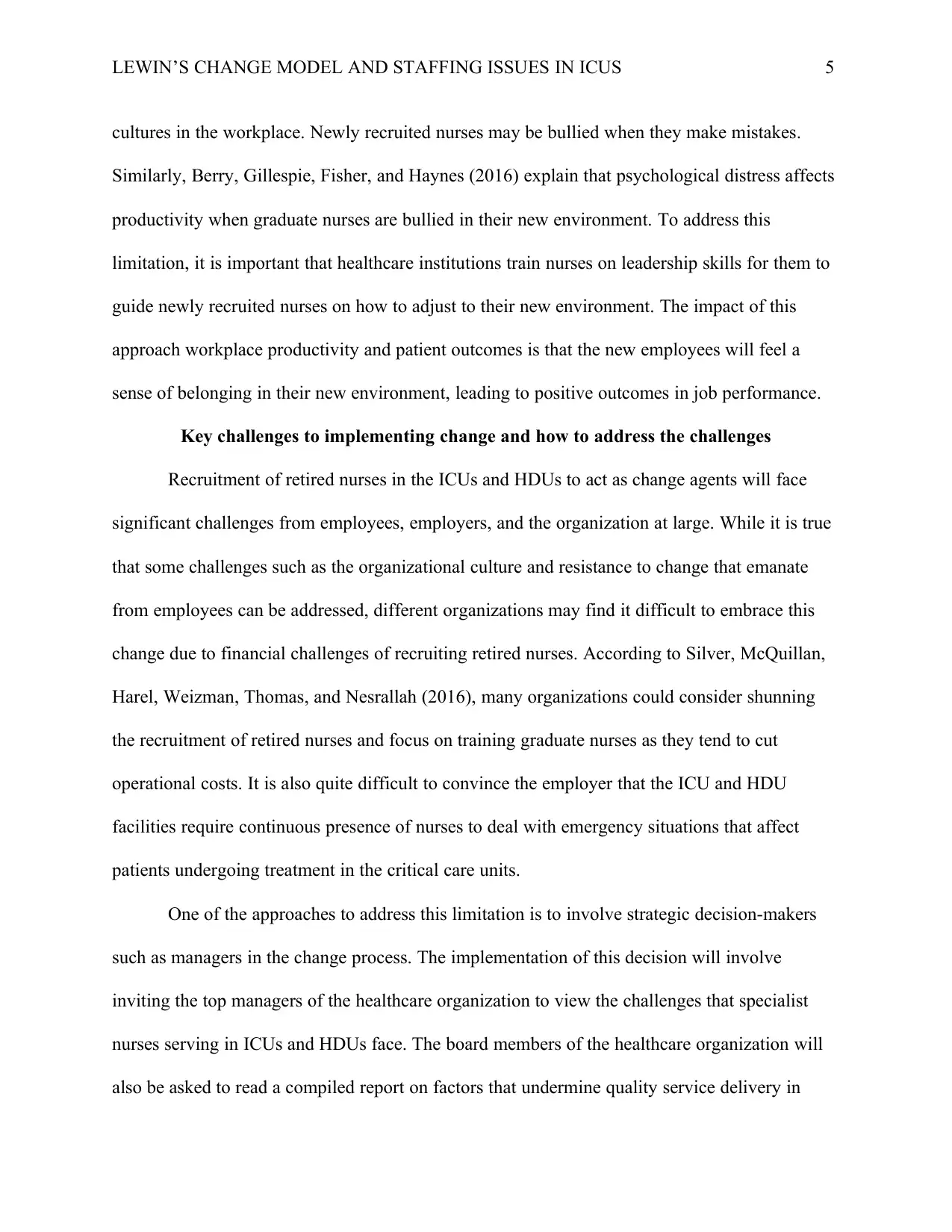
LEWIN’S CHANGE MODEL AND STAFFING ISSUES IN ICUS 5
cultures in the workplace. Newly recruited nurses may be bullied when they make mistakes.
Similarly, Berry, Gillespie, Fisher, and Haynes (2016) explain that psychological distress affects
productivity when graduate nurses are bullied in their new environment. To address this
limitation, it is important that healthcare institutions train nurses on leadership skills for them to
guide newly recruited nurses on how to adjust to their new environment. The impact of this
approach workplace productivity and patient outcomes is that the new employees will feel a
sense of belonging in their new environment, leading to positive outcomes in job performance.
Key challenges to implementing change and how to address the challenges
Recruitment of retired nurses in the ICUs and HDUs to act as change agents will face
significant challenges from employees, employers, and the organization at large. While it is true
that some challenges such as the organizational culture and resistance to change that emanate
from employees can be addressed, different organizations may find it difficult to embrace this
change due to financial challenges of recruiting retired nurses. According to Silver, McQuillan,
Harel, Weizman, Thomas, and Nesrallah (2016), many organizations could consider shunning
the recruitment of retired nurses and focus on training graduate nurses as they tend to cut
operational costs. It is also quite difficult to convince the employer that the ICU and HDU
facilities require continuous presence of nurses to deal with emergency situations that affect
patients undergoing treatment in the critical care units.
One of the approaches to address this limitation is to involve strategic decision-makers
such as managers in the change process. The implementation of this decision will involve
inviting the top managers of the healthcare organization to view the challenges that specialist
nurses serving in ICUs and HDUs face. The board members of the healthcare organization will
also be asked to read a compiled report on factors that undermine quality service delivery in
cultures in the workplace. Newly recruited nurses may be bullied when they make mistakes.
Similarly, Berry, Gillespie, Fisher, and Haynes (2016) explain that psychological distress affects
productivity when graduate nurses are bullied in their new environment. To address this
limitation, it is important that healthcare institutions train nurses on leadership skills for them to
guide newly recruited nurses on how to adjust to their new environment. The impact of this
approach workplace productivity and patient outcomes is that the new employees will feel a
sense of belonging in their new environment, leading to positive outcomes in job performance.
Key challenges to implementing change and how to address the challenges
Recruitment of retired nurses in the ICUs and HDUs to act as change agents will face
significant challenges from employees, employers, and the organization at large. While it is true
that some challenges such as the organizational culture and resistance to change that emanate
from employees can be addressed, different organizations may find it difficult to embrace this
change due to financial challenges of recruiting retired nurses. According to Silver, McQuillan,
Harel, Weizman, Thomas, and Nesrallah (2016), many organizations could consider shunning
the recruitment of retired nurses and focus on training graduate nurses as they tend to cut
operational costs. It is also quite difficult to convince the employer that the ICU and HDU
facilities require continuous presence of nurses to deal with emergency situations that affect
patients undergoing treatment in the critical care units.
One of the approaches to address this limitation is to involve strategic decision-makers
such as managers in the change process. The implementation of this decision will involve
inviting the top managers of the healthcare organization to view the challenges that specialist
nurses serving in ICUs and HDUs face. The board members of the healthcare organization will
also be asked to read a compiled report on factors that undermine quality service delivery in
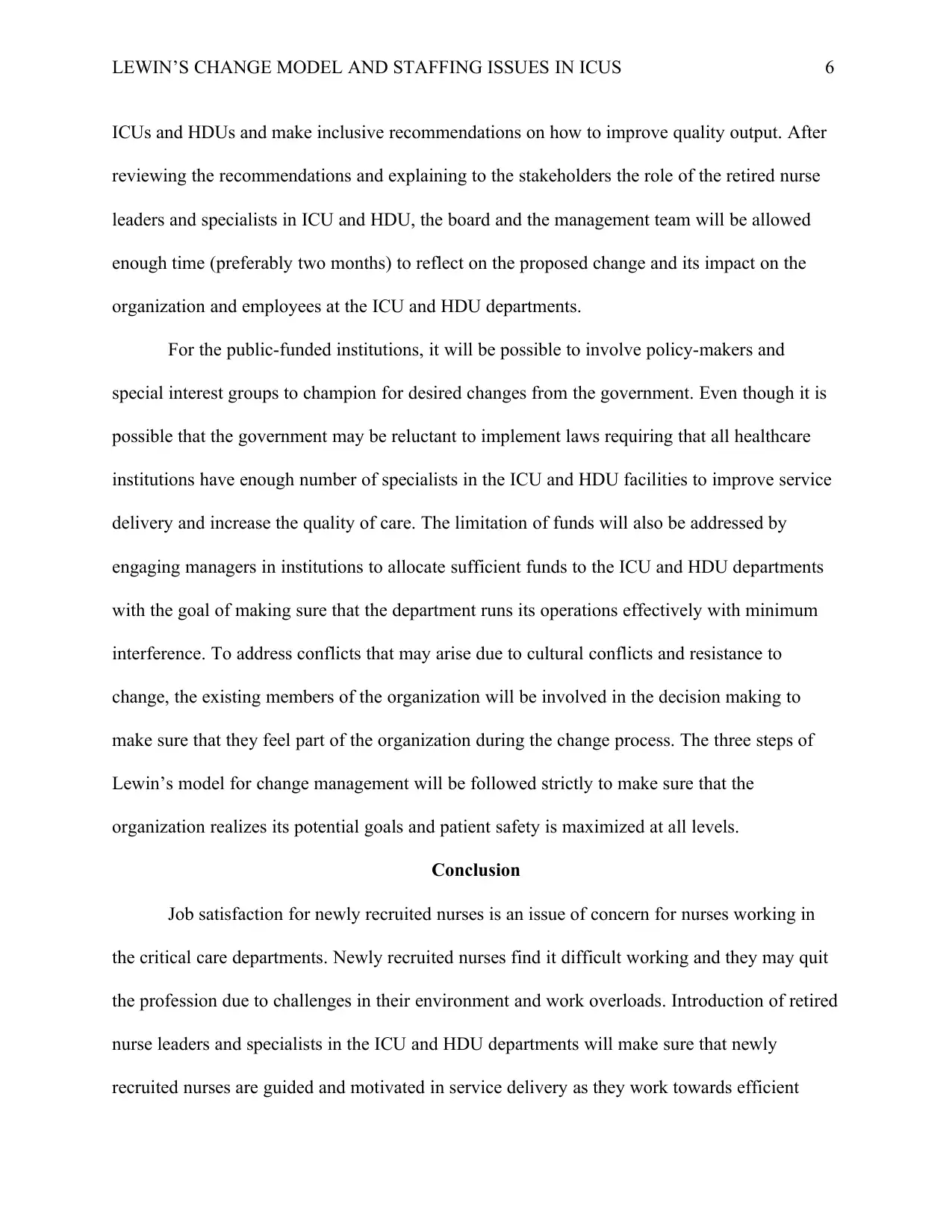
LEWIN’S CHANGE MODEL AND STAFFING ISSUES IN ICUS 6
ICUs and HDUs and make inclusive recommendations on how to improve quality output. After
reviewing the recommendations and explaining to the stakeholders the role of the retired nurse
leaders and specialists in ICU and HDU, the board and the management team will be allowed
enough time (preferably two months) to reflect on the proposed change and its impact on the
organization and employees at the ICU and HDU departments.
For the public-funded institutions, it will be possible to involve policy-makers and
special interest groups to champion for desired changes from the government. Even though it is
possible that the government may be reluctant to implement laws requiring that all healthcare
institutions have enough number of specialists in the ICU and HDU facilities to improve service
delivery and increase the quality of care. The limitation of funds will also be addressed by
engaging managers in institutions to allocate sufficient funds to the ICU and HDU departments
with the goal of making sure that the department runs its operations effectively with minimum
interference. To address conflicts that may arise due to cultural conflicts and resistance to
change, the existing members of the organization will be involved in the decision making to
make sure that they feel part of the organization during the change process. The three steps of
Lewin’s model for change management will be followed strictly to make sure that the
organization realizes its potential goals and patient safety is maximized at all levels.
Conclusion
Job satisfaction for newly recruited nurses is an issue of concern for nurses working in
the critical care departments. Newly recruited nurses find it difficult working and they may quit
the profession due to challenges in their environment and work overloads. Introduction of retired
nurse leaders and specialists in the ICU and HDU departments will make sure that newly
recruited nurses are guided and motivated in service delivery as they work towards efficient
ICUs and HDUs and make inclusive recommendations on how to improve quality output. After
reviewing the recommendations and explaining to the stakeholders the role of the retired nurse
leaders and specialists in ICU and HDU, the board and the management team will be allowed
enough time (preferably two months) to reflect on the proposed change and its impact on the
organization and employees at the ICU and HDU departments.
For the public-funded institutions, it will be possible to involve policy-makers and
special interest groups to champion for desired changes from the government. Even though it is
possible that the government may be reluctant to implement laws requiring that all healthcare
institutions have enough number of specialists in the ICU and HDU facilities to improve service
delivery and increase the quality of care. The limitation of funds will also be addressed by
engaging managers in institutions to allocate sufficient funds to the ICU and HDU departments
with the goal of making sure that the department runs its operations effectively with minimum
interference. To address conflicts that may arise due to cultural conflicts and resistance to
change, the existing members of the organization will be involved in the decision making to
make sure that they feel part of the organization during the change process. The three steps of
Lewin’s model for change management will be followed strictly to make sure that the
organization realizes its potential goals and patient safety is maximized at all levels.
Conclusion
Job satisfaction for newly recruited nurses is an issue of concern for nurses working in
the critical care departments. Newly recruited nurses find it difficult working and they may quit
the profession due to challenges in their environment and work overloads. Introduction of retired
nurse leaders and specialists in the ICU and HDU departments will make sure that newly
recruited nurses are guided and motivated in service delivery as they work towards efficient
⊘ This is a preview!⊘
Do you want full access?
Subscribe today to unlock all pages.

Trusted by 1+ million students worldwide
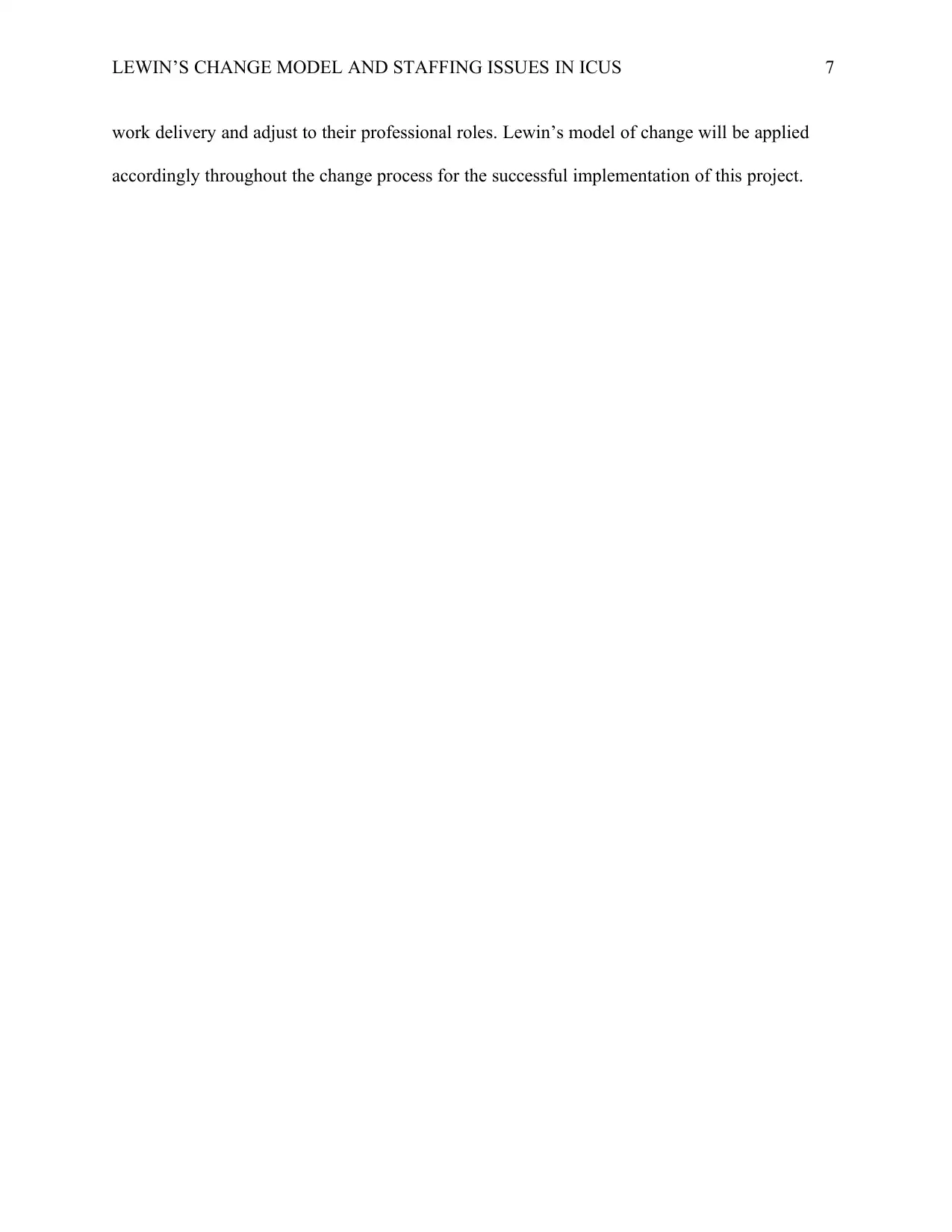
LEWIN’S CHANGE MODEL AND STAFFING ISSUES IN ICUS 7
work delivery and adjust to their professional roles. Lewin’s model of change will be applied
accordingly throughout the change process for the successful implementation of this project.
work delivery and adjust to their professional roles. Lewin’s model of change will be applied
accordingly throughout the change process for the successful implementation of this project.
Paraphrase This Document
Need a fresh take? Get an instant paraphrase of this document with our AI Paraphraser
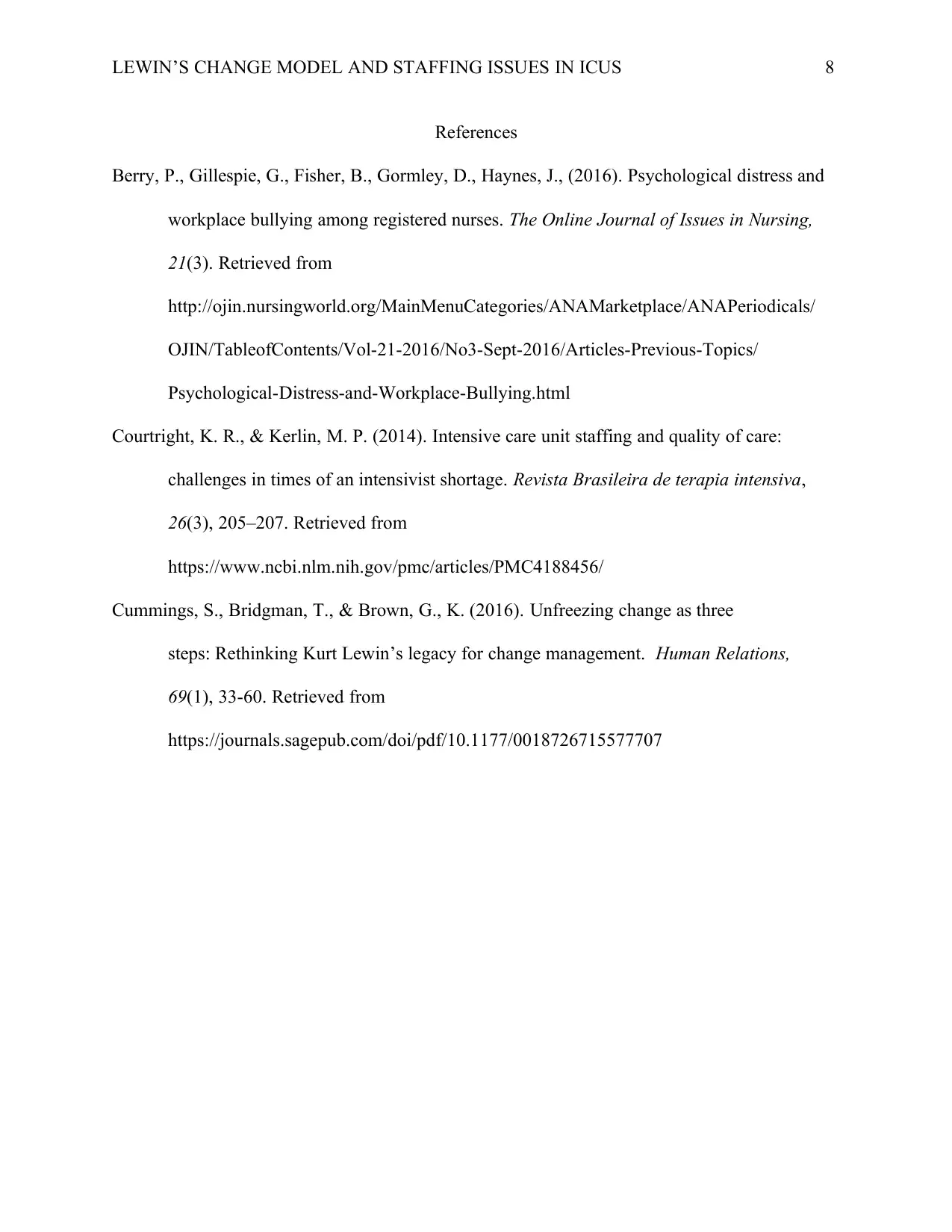
LEWIN’S CHANGE MODEL AND STAFFING ISSUES IN ICUS 8
References
Berry, P., Gillespie, G., Fisher, B., Gormley, D., Haynes, J., (2016). Psychological distress and
workplace bullying among registered nurses. The Online Journal of Issues in Nursing,
21(3). Retrieved from
http://ojin.nursingworld.org/MainMenuCategories/ANAMarketplace/ANAPeriodicals/
OJIN/TableofContents/Vol-21-2016/No3-Sept-2016/Articles-Previous-Topics/
Psychological-Distress-and-Workplace-Bullying.html
Courtright, K. R., & Kerlin, M. P. (2014). Intensive care unit staffing and quality of care:
challenges in times of an intensivist shortage. Revista Brasileira de terapia intensiva,
26(3), 205–207. Retrieved from
https://www.ncbi.nlm.nih.gov/pmc/articles/PMC4188456/
Cummings, S., Bridgman, T., & Brown, G., K. (2016). Unfreezing change as three
steps: Rethinking Kurt Lewin’s legacy for change management. Human Relations,
69(1), 33-60. Retrieved from
https://journals.sagepub.com/doi/pdf/10.1177/0018726715577707
References
Berry, P., Gillespie, G., Fisher, B., Gormley, D., Haynes, J., (2016). Psychological distress and
workplace bullying among registered nurses. The Online Journal of Issues in Nursing,
21(3). Retrieved from
http://ojin.nursingworld.org/MainMenuCategories/ANAMarketplace/ANAPeriodicals/
OJIN/TableofContents/Vol-21-2016/No3-Sept-2016/Articles-Previous-Topics/
Psychological-Distress-and-Workplace-Bullying.html
Courtright, K. R., & Kerlin, M. P. (2014). Intensive care unit staffing and quality of care:
challenges in times of an intensivist shortage. Revista Brasileira de terapia intensiva,
26(3), 205–207. Retrieved from
https://www.ncbi.nlm.nih.gov/pmc/articles/PMC4188456/
Cummings, S., Bridgman, T., & Brown, G., K. (2016). Unfreezing change as three
steps: Rethinking Kurt Lewin’s legacy for change management. Human Relations,
69(1), 33-60. Retrieved from
https://journals.sagepub.com/doi/pdf/10.1177/0018726715577707
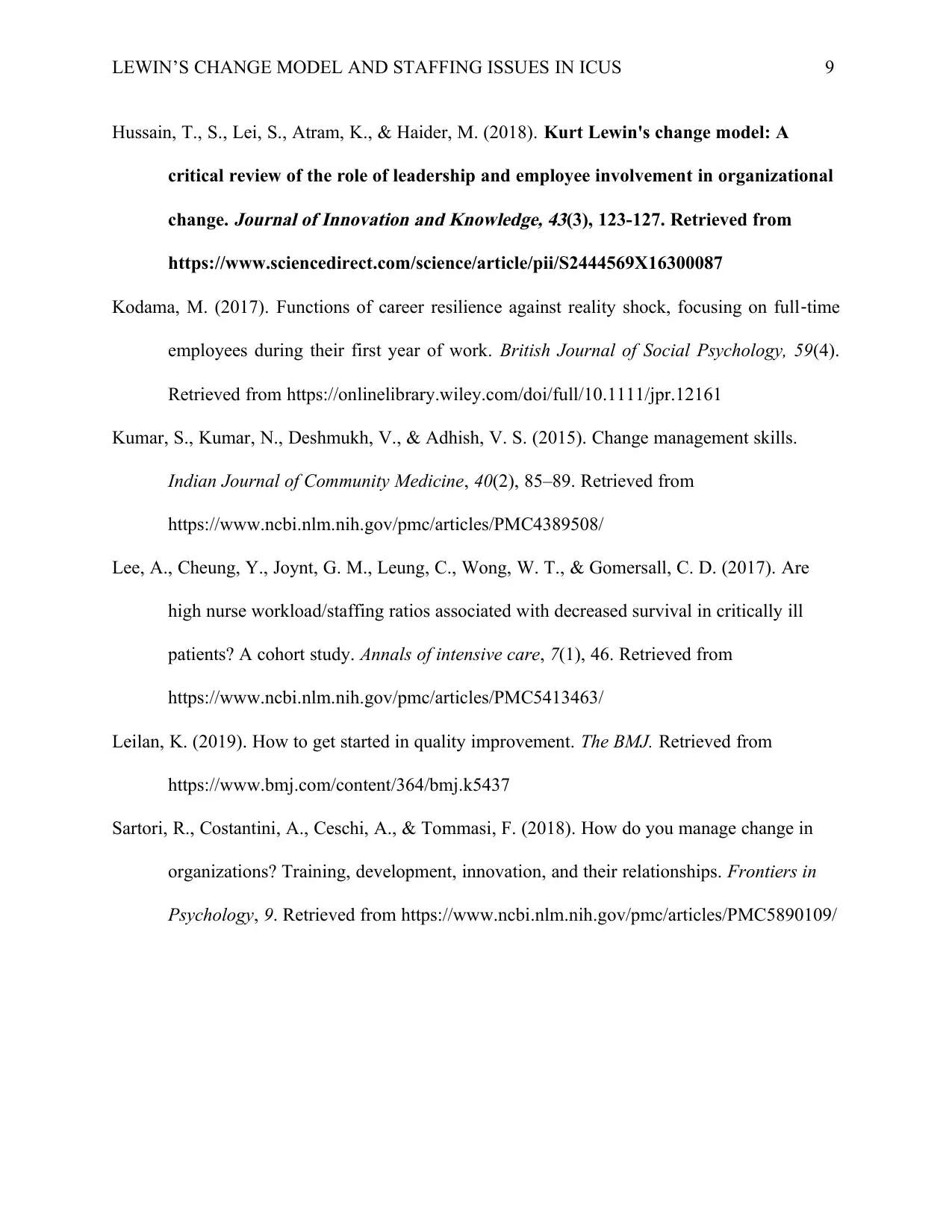
LEWIN’S CHANGE MODEL AND STAFFING ISSUES IN ICUS 9
Hussain, T., S., Lei, S., Atram, K., & Haider, M. (2018). Kurt Lewin's change model: A
critical review of the role of leadership and employee involvement in organizational
change.
Journal of Innovation and Knowledge, 43(3), 123-127. Retrieved from
https://www.sciencedirect.com/science/article/pii/S2444569X16300087
Kodama, M. (2017). Functions of career resilience against reality shock, focusing on full‐time
employees during their first year of work. British Journal of Social Psychology, 59(4).
Retrieved from https://onlinelibrary.wiley.com/doi/full/10.1111/jpr.12161
Kumar, S., Kumar, N., Deshmukh, V., & Adhish, V. S. (2015). Change management skills.
Indian Journal of Community Medicine, 40(2), 85–89. Retrieved from
https://www.ncbi.nlm.nih.gov/pmc/articles/PMC4389508/
Lee, A., Cheung, Y., Joynt, G. M., Leung, C., Wong, W. T., & Gomersall, C. D. (2017). Are
high nurse workload/staffing ratios associated with decreased survival in critically ill
patients? A cohort study. Annals of intensive care, 7(1), 46. Retrieved from
https://www.ncbi.nlm.nih.gov/pmc/articles/PMC5413463/
Leilan, K. (2019). How to get started in quality improvement. The BMJ. Retrieved from
https://www.bmj.com/content/364/bmj.k5437
Sartori, R., Costantini, A., Ceschi, A., & Tommasi, F. (2018). How do you manage change in
organizations? Training, development, innovation, and their relationships. Frontiers in
Psychology, 9. Retrieved from https://www.ncbi.nlm.nih.gov/pmc/articles/PMC5890109/
Hussain, T., S., Lei, S., Atram, K., & Haider, M. (2018). Kurt Lewin's change model: A
critical review of the role of leadership and employee involvement in organizational
change.
Journal of Innovation and Knowledge, 43(3), 123-127. Retrieved from
https://www.sciencedirect.com/science/article/pii/S2444569X16300087
Kodama, M. (2017). Functions of career resilience against reality shock, focusing on full‐time
employees during their first year of work. British Journal of Social Psychology, 59(4).
Retrieved from https://onlinelibrary.wiley.com/doi/full/10.1111/jpr.12161
Kumar, S., Kumar, N., Deshmukh, V., & Adhish, V. S. (2015). Change management skills.
Indian Journal of Community Medicine, 40(2), 85–89. Retrieved from
https://www.ncbi.nlm.nih.gov/pmc/articles/PMC4389508/
Lee, A., Cheung, Y., Joynt, G. M., Leung, C., Wong, W. T., & Gomersall, C. D. (2017). Are
high nurse workload/staffing ratios associated with decreased survival in critically ill
patients? A cohort study. Annals of intensive care, 7(1), 46. Retrieved from
https://www.ncbi.nlm.nih.gov/pmc/articles/PMC5413463/
Leilan, K. (2019). How to get started in quality improvement. The BMJ. Retrieved from
https://www.bmj.com/content/364/bmj.k5437
Sartori, R., Costantini, A., Ceschi, A., & Tommasi, F. (2018). How do you manage change in
organizations? Training, development, innovation, and their relationships. Frontiers in
Psychology, 9. Retrieved from https://www.ncbi.nlm.nih.gov/pmc/articles/PMC5890109/
⊘ This is a preview!⊘
Do you want full access?
Subscribe today to unlock all pages.

Trusted by 1+ million students worldwide
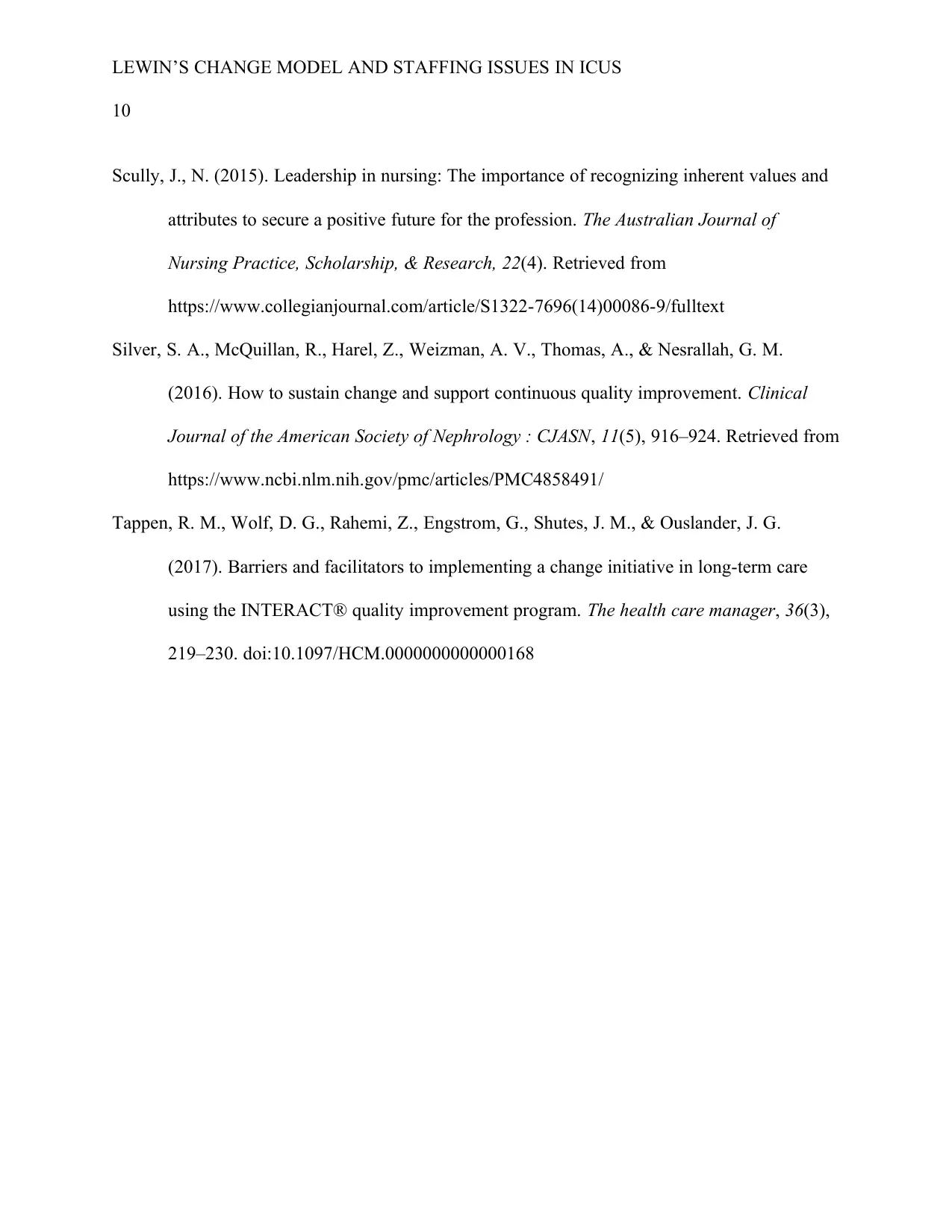
LEWIN’S CHANGE MODEL AND STAFFING ISSUES IN ICUS
10
Scully, J., N. (2015). Leadership in nursing: The importance of recognizing inherent values and
attributes to secure a positive future for the profession. The Australian Journal of
Nursing Practice, Scholarship, & Research, 22(4). Retrieved from
https://www.collegianjournal.com/article/S1322-7696(14)00086-9/fulltext
Silver, S. A., McQuillan, R., Harel, Z., Weizman, A. V., Thomas, A., & Nesrallah, G. M.
(2016). How to sustain change and support continuous quality improvement. Clinical
Journal of the American Society of Nephrology : CJASN, 11(5), 916–924. Retrieved from
https://www.ncbi.nlm.nih.gov/pmc/articles/PMC4858491/
Tappen, R. M., Wolf, D. G., Rahemi, Z., Engstrom, G., Shutes, J. M., & Ouslander, J. G.
(2017). Barriers and facilitators to implementing a change initiative in long-term care
using the INTERACT® quality improvement program. The health care manager, 36(3),
219–230. doi:10.1097/HCM.0000000000000168
10
Scully, J., N. (2015). Leadership in nursing: The importance of recognizing inherent values and
attributes to secure a positive future for the profession. The Australian Journal of
Nursing Practice, Scholarship, & Research, 22(4). Retrieved from
https://www.collegianjournal.com/article/S1322-7696(14)00086-9/fulltext
Silver, S. A., McQuillan, R., Harel, Z., Weizman, A. V., Thomas, A., & Nesrallah, G. M.
(2016). How to sustain change and support continuous quality improvement. Clinical
Journal of the American Society of Nephrology : CJASN, 11(5), 916–924. Retrieved from
https://www.ncbi.nlm.nih.gov/pmc/articles/PMC4858491/
Tappen, R. M., Wolf, D. G., Rahemi, Z., Engstrom, G., Shutes, J. M., & Ouslander, J. G.
(2017). Barriers and facilitators to implementing a change initiative in long-term care
using the INTERACT® quality improvement program. The health care manager, 36(3),
219–230. doi:10.1097/HCM.0000000000000168
1 out of 10
Your All-in-One AI-Powered Toolkit for Academic Success.
+13062052269
info@desklib.com
Available 24*7 on WhatsApp / Email
![[object Object]](/_next/static/media/star-bottom.7253800d.svg)
Unlock your academic potential
Copyright © 2020–2025 A2Z Services. All Rights Reserved. Developed and managed by ZUCOL.
